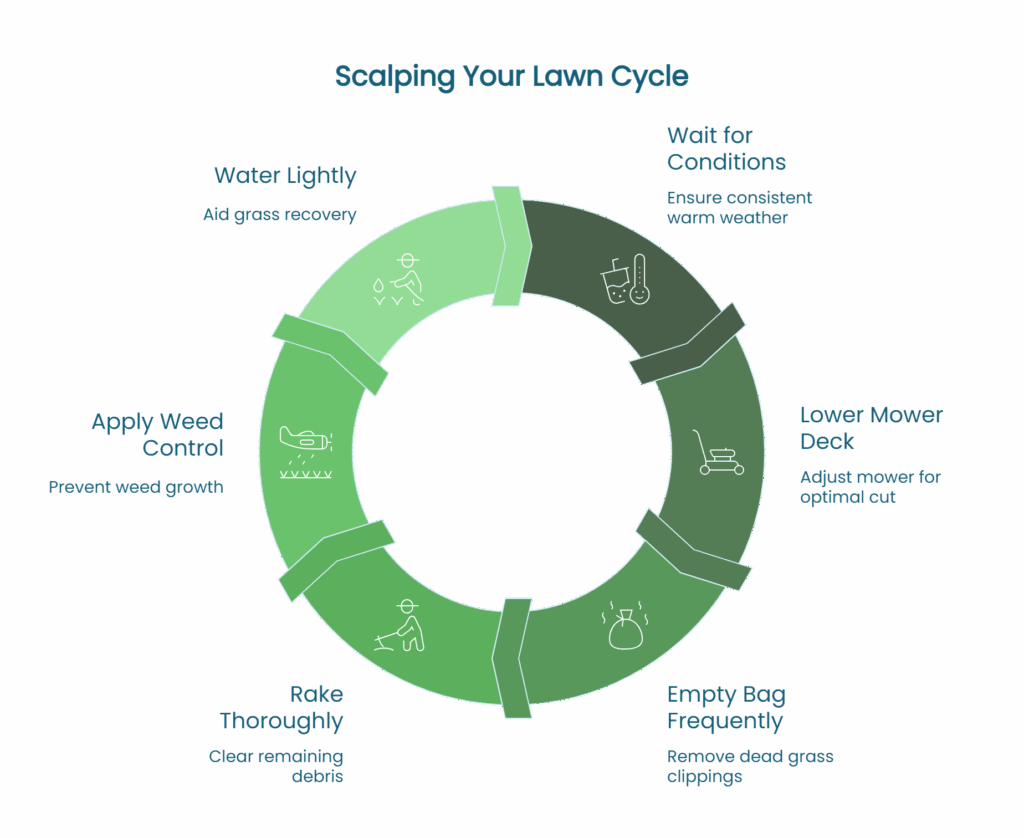When is the Best Time to Scalp Your Lawn & What Are the Benefits?
You’ve probably noticed your neighbor’s lawn looking oddly short—almost like a golf course putting green—early in the spring. Maybe you’ve wondered if they made a terrible mistake or if they know something you don’t. That super-short cut is called “scalping,” and when done correctly, it’s actually a powerful technique for jumpstarting your lawn’s health.
What Exactly is Lawn Scalping?
Scalping means cutting your grass extremely low—much shorter than a regular mowing. This technique removes old, dead grass and thatch that accumulated over winter, essentially giving your lawn a fresh start.
Think of scalping like a reset button for your warm-season grass. It clears away the old growth so new, healthy grass can push through without competition.
The Right Time to Scalp Your Atlanta Lawn
Timing is everything when it comes to scalping. Get it wrong, and you might damage your lawn instead of helping it.
The best time to scalp a warm-season lawn in Atlanta is:
- Late February to early April when temperatures consistently stay above 60-65°F during the day
- After the last threat of frost has passed
- When you notice the first signs of green growth at the base of your grass
- Before the grass has fully greened up
Our Georgia weather patterns can be unpredictable, so watching those early spring temperatures is crucial. Scalp too early, and a late frost could damage vulnerable new growth. Scalp too late, and you’ll cut away the fresh green grass you’re trying to encourage.
Benefits That Make Scalping Worth the Effort
Why put your lawn through such a dramatic haircut? The results speak for themselves:
- Faster green-up: Removing brown, dead growth allows sunlight to reach the soil, warming it faster
- Thatch removal: Eliminates the layer of dead grass that can block water and nutrients
- Disease prevention: Removes fungus and disease that might have overwintered in dead grass
- Weed control: Makes pre-emergent herbicides more effective by allowing them to reach the soil
- Even growth: Encourages uniform green-up across your entire lawn
One Smyrna homeowner told us, “I was skeptical about scalping my Bermuda grass the first time, but the difference was amazing. My lawn greened up weeks before my neighbors’ and stayed healthier all season.”
Which Grass Types Should Be Scalped?
Not all grass benefits from scalping. This technique works best for:
- Bermuda grass
- Zoysia grass
- St. Augustine (with caution—not as low as other types)
Cool-season grasses like Fescue, which are also found in parts of Georgia, should NOT be scalped. These grasses grow differently and won’t recover from such a dramatic cut.
Step-by-Step: How to Scalp Your Lawn Properly
Ready to give your lawn the ultimate spring refresh? Here’s how to do it right:
- Wait for the right conditions – consistent 60°F+ days with no frost in the forecast
- Lower your mower deck to cut at 1/2 to 3/4 inch for Bermuda or 1 inch for Zoysia
- Empty the bag frequently – you’ll collect a lot of dead grass
- Rake thoroughly after scalping to remove remaining debris
- Apply pre-emergent weed control immediately after scalping
- Water lightly to help your grass recover from the stress

Skip’s Tip: Make sure your mower blades are sharp before scalping. Dull blades tear the grass instead of cutting it cleanly, which can stress the plants and slow recovery.
Common Scalping Mistakes to Avoid
We’ve seen well-intentioned homeowners make these errors:
- Scalping too early when frost is still possible
- Cutting too low for their specific grass type
- Forgetting to adjust irrigation after scalping (freshly scalped lawns dry out faster)
- Not removing the clippings (which defeats the purpose of letting sunlight reach the soil)
- Scalping cool-season grasses like Fescue (which can kill them)
When to Call in the Professionals
While many homeowners handle scalping themselves, there are good reasons to consider professional help:
- If you’re unsure about your grass type
- When your lawn has multiple grass types requiring different approaches
- If your lawn has significant thatch buildup requiring dethatching equipment
- When you want to combine scalping with other spring treatments for maximum benefit
Professional scalping ensures the right height for your specific grass variety and can be coordinated with fertilization and pre-emergent applications for best results.
Your Lawn’s Next Steps After Scalping
After scalping, your lawn will look dramatically different—almost bare in spots. Don’t panic! This is normal. Here’s what happens next:
- Within 2-3 weeks, you’ll see fresh green growth emerging
- Apply a balanced fertilizer about 2 weeks after scalping
- Maintain regular watering without overwatering
- Resume normal mowing when the grass reaches about 2 inches in height
Within a month, your patience will be rewarded with a lush, even, healthy lawn that’s primed for the growing season.
Is Scalping Right for Your Lawn?
Scalping offers significant benefits for warm-season lawns in the Atlanta area, but it might not be right for every situation. Factors to consider include:
- Your specific grass type
- The current health of your lawn
- Whether you’re dealing with existing lawn problems
- Your irrigation system’s efficiency
- Your lawn maintenance schedule
Not sure if scalping would benefit your specific lawn? Skip and our team at Yardsy are happy to assess your lawn’s needs and make personalized recommendations.
Ready to give your lawn the perfect spring start? Get a free lawn assessment from Yardsy’s turf experts and find out if scalping is right for your grass. We’ll create a custom plan to ensure your lawn thrives all season long.
Written by Jonathan Gillespie, Director of Agronomy at Yardsy, who brings over 25 years of expertise in lawn care and turf management.
